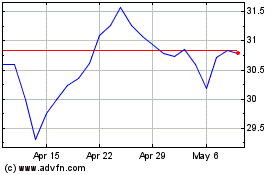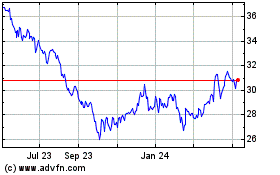Timely Turkey Tips from Buying to Baking; American Dietetic Association/ConAgra Foods offer Home Food Safety Help for Thanksgivi
November 10 2005 - 2:54PM
Business Wire
Bird is the word! In just three weeks, more than 45 million turkeys
will be the guests of honor at nearly every Thanksgiving meal in
the country (97 percent).(a) If you're hosting a great American
feast at your house, plan on a hearty helping of proper food safety
to ensure your holiday meal is perfect. "Often during the holidays,
people who rarely cook on typical days are suddenly in the kitchen
helping prepare various traditional dishes - which means foodborne
illness can be a serious concern," says registered dietitian Jackie
Newgent, national spokesperson for the American Dietetic
Association/ConAgra Foods Home Food Safety...It's in Your Hands(TM)
program. "The good news is home cooks can significantly reduce
their risk by following a few basic food safety procedures." Before
you buy, baste or bake, brush up on these turkey tips from the
American Dietetic Association and the ConAgra Foods Foundation.
Buying -- Always look for the "safe food handling" label on
packages. The label will give you tips for proper food handling and
cooking -- Make sure the packaging is tightly sealed -- Pick up the
turkey and other meat items last and ask to have them bagged
separately from other groceries Storing -- Make sure the
refrigerator temperature is set at below 40 degrees F -- To freeze
an uncooked, whole turkey, leave turkey in its original wrapping.
To freeze uncooked turkey parts, wrap in freezer wrap or tightly
sealed freezer bags and mark with the date -- A frozen, whole
turkey can be kept for approximately 12 months in a freezer set at
or below 0 degrees F -- Frozen turkey parts can be kept for
approximately nine months in a freezer set at or below 0 degrees F
-- To freeze cooked turkey, wrap in freezer wrap or tightly sealed
freezer bags and mark with the date -- Cooked turkey can be kept
frozen for approximately two to six months in a freezer set at or
below 0 degrees F -- Refrigerate leftover turkey promptly within
two hours of cooking -- Cooked turkey should be eaten or frozen
within three to four days Preparing -- Wash hands thoroughly for 20
seconds before, during and after handling raw poultry -- Use two
separate cutting boards to avoid cross-contamination, one for raw
foods and the other for ready-to-eat foods -- Refer to the "safe
food handling" label on the package for proper preparation -- For
more information, visit the USDA at
http://www.fsis.usda.gov/FactSheets/Lets_Talk_Turkey/index.asp
Thawing -- Thaw turkey in the refrigerator (never on the counter)
or in the microwave using the defrost setting or under cold water
-- For safe thawing in the refrigerator, allow about one day for
every four to five pounds of turkey to thaw in the refrigerator --
When thawing turkey in the microwave, follow the owner's manual.
Cook immediately after thawing because some areas may become warm
and begin to cook during microwaving -- Turkey may also be thawed
in cold water in its original airtight packaging or in a leak-proof
bag. Submerge the bird or cut-up parts in cold water, changing the
water every 30 minutes. Estimate minimum thawing time to be 30
minutes per pound for whole turkey -- Do not re-freeze thawed
turkey Cooking -- Use a meat thermometer to cook to proper internal
temperature -- The temperature of a whole turkey must reach 180
degrees F deep in the thigh -- The temperature of turkey breast
should reach 170 degrees F -- When cooking a stuffed turkey, the
center of the stuffing must reach 165 degrees F. For safety and
uniform doneness of turkey, cook stuffing separately For more
seasonal home food safety help, visit www.homefoodsafety.org. The
ADA/ConAgra Foods Home Food Safety ...It's in Your Hands(TM)
program educates consumers that home food safety is a serious issue
and provides solutions so Americans can easily and safely handle
food in their own kitchens. This program complements
government-sponsored food safety initiatives that speak to the
leading critical food-handling violations by emphasizing the
following four key messages: 1) Wash hands often; 2) Keep raw meats
and ready-to-eat foods separate; 3) Cook to proper temperatures; 4)
Refrigerate promptly below 40 degrees Fahrenheit. For more
information, visit www.homefoodsafety.org or call ADA's Consumer
Nutrition Information Line at 800/366/1655, where recorded messages
are available 24 hours a day. With nearly 65,000 members, the
American Dietetic Association is the nation's largest organization
of food and nutrition professionals. The Chicago-based ADA serves
the public by promoting optimal nutrition, health and well-being.
Visit ADA at www.eatright.org. ConAgra Foods, Inc. (NYSE:CAG) is
one of North America's largest packaged food companies, serving
consumer grocery retailers, as well as restaurants and other
foodservice establishments. The home food safety education program
is a program of the ConAgra Foods Foundation, the philanthropic arm
of ConAgra Foods, which works to improve the quality of life in
communities across the country. (a) Source: University of Minnesota
News, 2004
ConAgra Brands (NYSE:CAG)
Historical Stock Chart
From Jun 2024 to Jul 2024

ConAgra Brands (NYSE:CAG)
Historical Stock Chart
From Jul 2023 to Jul 2024
